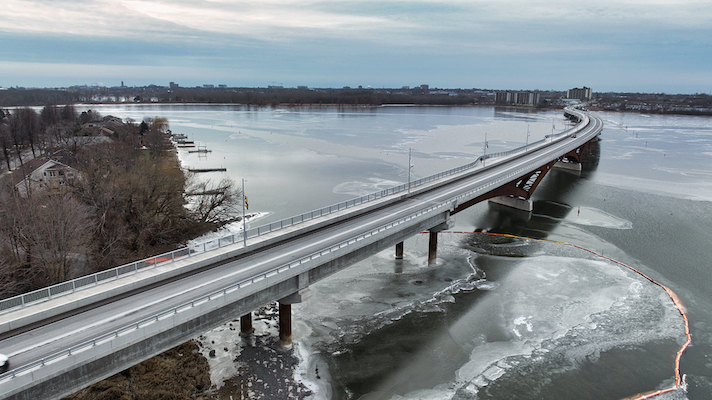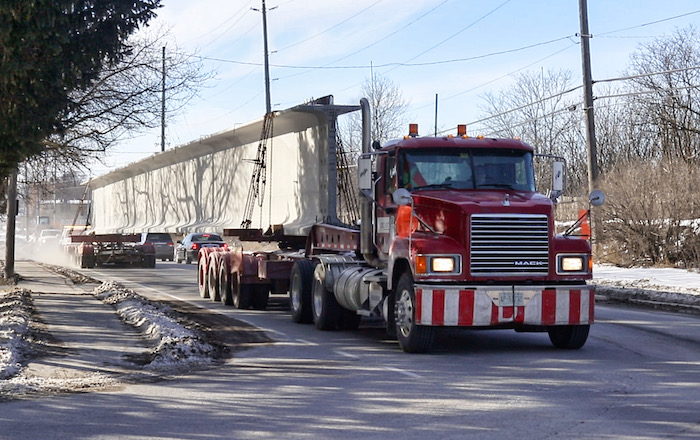
2023 #CCEAwards Showcase: Waaban Crossing
November 1, 2023
By CCE
“One of first integrated project delivery (IPD) undertakings outside buildings, this will be huge for people in Kingston.” – Jury
Category: Transportation
Award of Excellence Winners: Hatch and Systra IBT
For many years, the City of Kingston, Ont., recognized a new, third crossing of the Cataraqui River was needed to connect communities on both sides and to accommodate regional growth. In 2018, with funding secured, the city implemented the project using an integrated project delivery (IPD) model and signed a contract with Hatch, Systra IBT and Kiewit.
Together, despite the pandemic, this team completed the 1.2-km long bridge on time and under budget. It is Kingston’s largest infrastructure project to date.
North America’s first IPD bridge
The most significant innovation for the project was the IPD approach, which was wholeheartedly adopted by the city, the engineers (Hatch and Systra), the contractor (Kiewit) and its trade partners (Bauer Foundations and Walters Group). While IPD had been used for building construction, this was the first time it would be used in North America for a bridge.
In the IPD model, all parties—including owner, engineer and constructor—sign a joint contract that incentivizes them to set aside their individual interests and act as a team to make the decisions that are best for the project. The agreement achieves collaboration in several ways:
- All parties are fully involved in project development, design and construction.
- Project decisions must be unanimous between the parties and made in consideration of project outcomes.
- The agreement precludes the parties from submitting claims against each other.
- The consultant and contractor are paid all of their costs (excluding profit) by the owner.
- Profit is put at risk and earned by meeting project goals; e.g. meeting a timeline, obtaining approvals and permits or achieving local purchasing targets.
This approach let the team work together during the project validation period, from 2018 to 2019, to modify and refine the bridge design concept and construction methodology from those in an earlier environmental assessment (EA), with the goal of bringing the target cost within the budget of $180 million.
Major cost-saving innovations were conceived during the validation period:
- The approach span substructure design was simplified from the V-piers proposed in the EA to modified conventional vertical piers and pier caps, with a less ‘heavy’ and more ‘open’ appearance.
- The steel approach spans were replaced by 48-m long precast concrete Nebraska University (NU) girders. These were the longest girders that could be manufactured (with minor modifications to the precast plant), delivered by road and lifted into place on-site. Indeed, they were the largest concrete girders ever produced in Ontario!
- Since providing a temporary trestle in the river from which to construct the new bridge would represent a significant cost, a hybrid approach was selected instead, using a combination of a causeway in the shallow areas, a trestle in the deeper areas and a temporary lift-bridge over the navigation channel.
The resulting concept included the 1.2-km bridge with onshore approach roads providing connections at John Counter Boulevard on the west side of the river and Gore Road on the east side. A bridge deck cross-section width of 15.6 m would accommodate a two-lane roadway and a multi-use trail on the south side, separated from the roadway by a traffic barrier and widening out into two observation lookouts above the main span piers.
Local benefits
The city’s vision was to provide an iconic structure that would give residents a sense of pride, attract tourism and respect the natural environment. The more specific benefits would be to connect communities on the east and west sides of the Cataraqui, improve emergency response times, accommodate future growth and promote active and public transportation alternatives.
Another advantage of the IPD approach was to allow the city to encourage local participation in construction, by setting goals that would benefit local businesses and residents. As a result, the project team procured more than $22.7 million worth of locally sourced material and contracts, used more than 326,000 hours of labour from workers living within 115 km of Kingston (with more than 168,000 of those hours from those within 40 km), secured 93 contracts with local businesses, employed 38 staff members who moved to Kingston to work on the project, donated more than $15,000 to local charitable causes and contributed more than 80 community service hours.
Addressing environmental concerns
The Cataraqui River, which divides Kingston, is part of the Rideau Canal system and is a United Nations Educational, Scientific and Cultural Organization (UNESCO) World Heritage Site, a National Historic Site of Canada (NHSC), a Canadian Heritage River and a federally regulated navigable waterway. Environmental concerns regarding the construction and operation of the new crossing were significant.
To obtain approval from Parks Canada, a means of mitigating impacts was developed. To ensure such measures are successful, the city will monitor the river for several years after the completion of the bridge’s construction.
Further, the new crossing will encourage active transportation with its bike lanes and walking paths, shorten journey times across the river by an estimated 40%, allow for expansion of transit routes, provide a potential emergency detour route for the provincial Highway 401 and improve access to services. The city estimates these benefits will reduce vehicular travel by 60 million km and greenhouse gas (GHG) emissions by 14,000 t per year.
The IPD approach also had environmental benefits. The slimmer pier design reduced the in-water footprint of the bridge by more than 50%. Parks Canada praised the lowered bridge profile because it fitted within the surrounding UNESCO heritage site, rather than dominating it.
Working together
The city opened the new bridge to the public with a ribbon-cutting ceremony on Dec. 13, 2022, and named it Waaban Crossing. (‘Waaban’ is an Ojibwe term for dawn or morning light.)
“This is a moment to savour,” said Bryan Paterson, the city’s mayor. “This is a moment we have all earned by working together.”
Waaban Crossing, Kingston, Ont.
Award-winning firm (prime consultant): Hatch, Mississauga, Ont. (Biljana Rajlic P.Eng.; Geoff Bubbers, P.Eng.; Svetozar Majstorovic, P.Eng.; Arash Khoshghalb, P.Eng.; Radek Falar, P.Eng.; Rob Short, P.Eng.; Majella Anson-Cartwright, P.Eng.; Mark Armstrong, P.Eng.; Caleb Coughlin; Cody Presley; Adam Kolankowski, EIT; Philip Murray, P.Eng.).
Award-winning firm (consultant for main bridge span): Systra IBT, Montreal, Que. (Zac McGain, P.Eng.).
Owner: City of Kingston.
Other key players: Tulloch (geotechnical consultant), Moon-Matz (electrical consultant), Beam Architects (bridge architect), Kiewit (main contractor), Bauer Foundations (foundation contractor), Walters Group (steel fabrication and erection).

